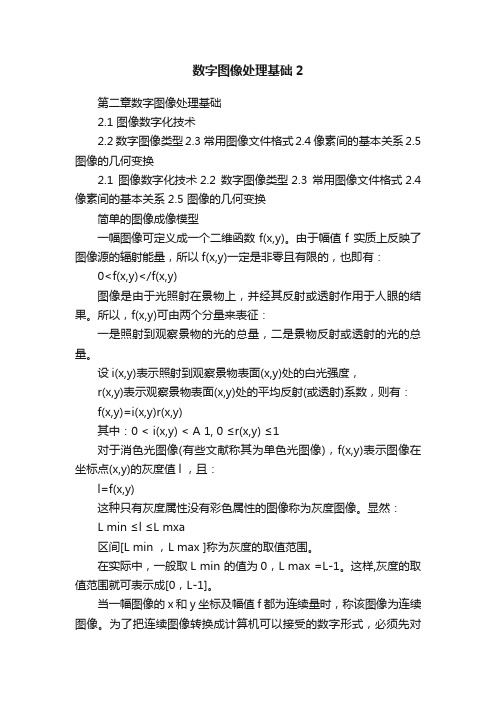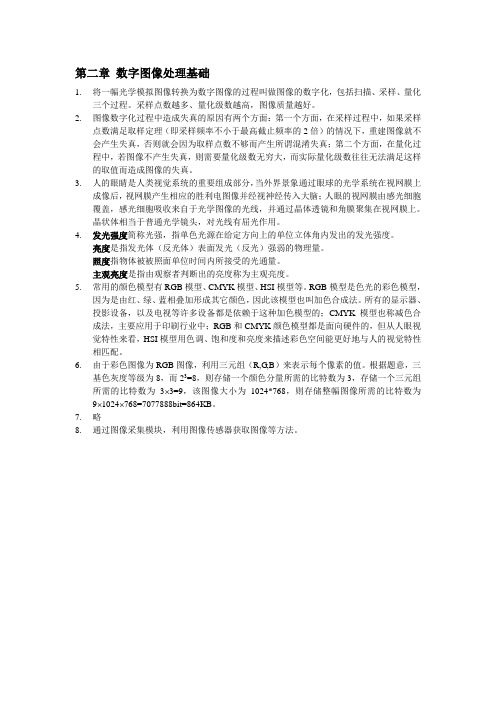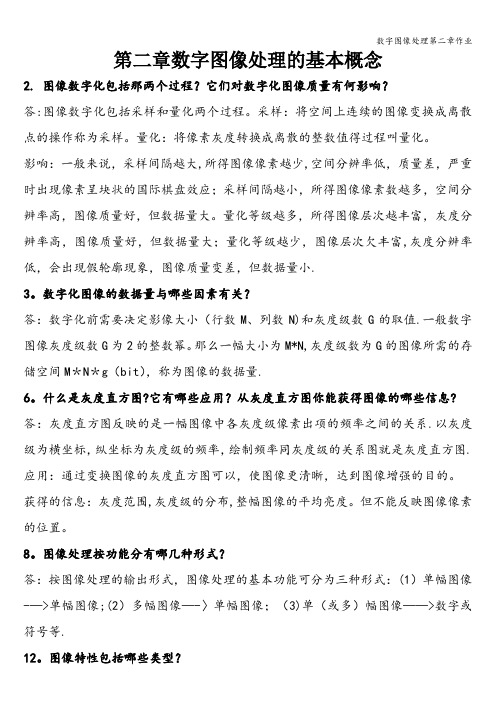数字图像处理-第二章
数字图像处理第2章图像数字化

续图像的频谱与它的平移复制品重叠。
的高频分量混入到它的中频或低频部分,这种现象称为
混叠。在这种情况下,由函数的采样值重建的图像将产生失真。如图 2-1-4 所示,由于采样间隔不满足
奈奎斯特条件,采样图像的频谱在阴影区及其附近产生了混叠。当我们用图示的低通滤波器
取
出
重建图像时,将会带来两个问题:
(1) 图像信号损失了一部分高频分量,致使图像变得模糊。
像,但需要付出更大的存储空间作为代价。
连续图像
在二维空间域里进行采样时,常用的方法是对
进行均匀采样。取得各点的亮
度值,构成一个离散的函数 函数来表示,即
。若是彩色图像,则以三基色 R、G、B 的亮度作为分量的三维向量
1
相应的离散向量函数用(1.1.7)表示。
图 2-1-2 采样示意图(2) 评价连续图像经过采样获得数字图像的效果,采用如下一些参数。 图像分辨率是指采样所获得图像的总像素。例如,640×480 图像的总像素数为 307 200 个。在购买 具有这种分辨率的数码相机时,产品性能介绍上会给出 30 万像素分辨率这一参数。 采样密度是指在图像上单位长度所包含的采样点数。采样密度的倒数就是像素间距。 采样频率是指一秒钟内采样的次数。它反映了采样点之间的间隔大小。采样频率越高,丢失的信息 越少,采样后获得的样本更细腻逼真,图像的质量更好,但要求的存储量也就更大。 扫描分辨率表示一台扫描仪输入图像的细微程度。它指每英寸扫描所得到的点,单位是 dpi (dot per inch)。数值越大,表示被扫描的图像转化为数字化图像越逼真,扫描仪质量也越好。无论采用哪种评价 参数,实际上在进行采样时,采样点间隔的选取是一个非常重要的参数。
(a) 中央上升型
(b) 中央平稳型
第二章 数字图像处理基础

2.1 数字图像的表示 2.2 数字图像的采样与量化 2.3 人的视觉特性 2.4 光度学与色度学原理
第二章 数字图像处理基础
本章重点、难点
重点: 采样和量化 BMP图像文件格式 RGB颜色模型和HSI颜色模型 难点: 采样和量化的理解 BMP位图
2.1 数字图像
数字图像:f(x,y),函数值对应于图像点的 亮度。称亮度图像。 注意:模拟图像与数字图像的区别 动态图像:f(x,y,t)
人眼成像过程
视细胞分为两类: 锥状细胞:明视细胞,在强光下检测亮度 和颜色。 杆(柱)状细胞:暗视细胞,在弱光下检测亮 度,无色彩感觉。 人眼成像过程
图像的对比度和亮度
人眼的亮度感觉 图像 “黑”“白”(“亮”、“暗”)对比参数 对比度 : c=Bmax/Bmin 相对对比度:cr=(B-B0)/B0 人眼亮度感觉范围 总范围很宽 c = 108 人眼适应某一环境亮度后,范围限制 适当平均亮度下:c=103 很低亮度下:c=10
亮度
也称为灰度,它是颜色的明暗变化,常用 0 %~ 100 % (由黑到白) 表示。以下三幅图是 不同亮度对比。
对比度
对比度(contrast)是亮度的局部变化,定义为物体亮 度的平均值与背景亮度的比值,是画面黑与白的比 值,也就是从黑到白的渐变层次。比值越大,从黑 到白的渐变层次就越多,从而色彩表现越丰富。人 眼对亮度的敏感性成对数关系。
同时对比度
人眼对某个区域感觉到的亮度不是简单 地取决于该区域的强度,背景亮度不同 时,人眼所感觉到的明暗程度也不同。
马赫带效应
马赫带(Mach Band)效应:边界处亮度对比加强
为什么我们要在暗室评片?
马赫带效应的出现,是因为人眼对于图像中不同 空间频率具有不同的灵敏度,而在空间频率突变处 就出现了 “欠调”或“过调”
第2章数字图像处理基础

DWORD
biSize;
LONG
biWidth;
LONG
biHeight;
WORD
biPlanes;
WORD
biBitCount;
DWORD
biCompression;
DWORD
biSizeImage;
LONG
biXPelsPerMeter;
LONG
biYPelsPerMeter;
DWORD
biClrUsed;
} BITMAPFILEHEADER;
这个结构的长度是固定的,为14个字节(WORD为无符号16位二 进制整数,DWORD为无符号32位二进制整数)。
第二部分为位图信息头BITMAPINFOHEADER,也是一个结构,其定义如下:
typedef struct tagBITMAPINFOHEADER{
R、 G、 B 值。下面就2色、 16色、256 色和真彩色位图分别介绍。
对于2色位图,用1位就可以表示该像素的颜色(一般0表示 黑, 1表示白),所以一个字节可以表示8个像素。
对于16色位图,用4位可以表示一个像素的颜色,所以一个 字节可以表示2个像素。
对于256色位图,一个字节刚好可以表示1个像素。
下面两点请读者注意:
(1) 每一行的字节数必须是4的整数倍,如果不是,则需 要补齐。这在前面介绍biSizeImage时已经提到过。
(2) BMP文件的数据存放是从下到上,从左到右的。也 就是说, 从文件中最先读到的是图像最下面一行的左边第一个 像素, 然后是左边第二个像素, 接下来是倒数第二行左边第 一个像素, 左边第二个像素。依次类推, 最后得到的是最上 面一行的最右边的一个像素。
2.3.1 BMP图像文件格式
精品课件-数字图像处理-第2章

21 图2.1.3 人眼的主观亮度感觉与亮度的关系
22
由此可见,人眼在适应某一平均亮度时,黑、白感觉对 应的亮度范围较小,随着平均亮度的降低,黑白感觉的亮度 范围变窄。黑、白亮度感觉的相对性为图像传输与重现带来 了方便,这体现在以下两个方面:
(1)重现图像的亮度不必等于实际图像的亮度,只要保 持两者的对比度不变,就能给人以真实的感觉;
30 图2.1.4 色度图
31
图2.1.4所示为色度图中一些点的颜色。中心的C点对应 白色,由三原色各1/3组合产生。图2.1.4中P点的色度坐标x =0.48,y=0.40。由C通过P画一条直线至边界上的Q点(约 590 nm),P点颜色的主波长即为590 nm,此处光谱的颜色即 为Q点的色调(橙色)。图2.1.4中P点位于从C到纯橙色点的 66%的地方,所以它的色纯度(饱和度)是66%。
色调和饱和度合起来称为色度。颜色可用亮度和色度共 同表示。设组成某种颜色C所需的3个刺激量分别用X、Y、Z 表示,而每种刺激量的比例系数为x、y、z,则有
C=xX+yY+zZ 比例系数x、y、z也称为色系数:
x X X Y Z
y Y X Y Z
z Z X Y Z
由这些式子可以看出: x+y+z=1
26
(2.1.6) (2.1.7) (2.1.8) (2.1.9)
27
1931年CIE制定了一个色度图(见图2.1.4,图中波长单 位是 nm),用组成某种颜色的三原色的比例来规定这种颜色。 图中横轴对应红色色系数,纵轴对应绿色色系数,蓝色色系 数可由z=1-(x+y)求得。图中各点给出光谱中各颜色的色 度坐标,蓝紫色在图的左下部,绿色在图的左上部,红色在 图的右下部。连接400 nm和700 nm的直线是光谱上所没有的 由紫到红的系列。通过对该图的观察分析可知:
数字图像处理 第2章 图像的数字化与显示

(2.20)
2.3.3 空间与灰 度级分辨率
对一幅图像,当量化级数Q一定 时,采样点数 M×N 对图像质量有着显 著的影响。采样点数越多,图像质量越 好;当采样点数减少时,图像越小,图 上的块状效应就逐渐明显。
图像的采样与数字图像的质量
图像的量化与数字图像的质量
量化级数越多,图像质量越好,当量化级数越少时,图像质量越 差,量化级数最小的极端情况就是二值图像,图像出现假轮廓。
2.2 图像场取样
2.2.1 取样和量化的基本概念
数字化包括取样和量化两个过程 :
取样(sampling):对空间连续坐标(x, y)的 离散化 量化(quantization):幅值 f (x, y)的离散化
(a)连续图像
(b)数字化结果
图2.1 图像的数字化过程
(a)
(b)
图2.2 采样网格 (a) 正方形网格; (b) 正六角形网格
截止频率。
u U c , v Vc u U c , v Vc
(2.8)
其中 U c , Vc 对应于空间位移变量x和y的最高
则当采样周期
x, y满足
(2.9)
1 u s 2U c x 1 vs 2Vc y
此时,通过采样信号 f ( mx, ny ) 能唯一地恢 复或重构出原图像信号f (x,y)。该条件称为 Nyquist采样定理。
• 2.3.1
•
标量量化
标量量化:将数值逐个量化 。 例:假设抽样信号的范围是0~5 V,将它分为8等
分,这样就有8个量化电平,分别是5/8 V,10/8 V,15/8 V,…,35/8 V。 对每一个采样将它量化为离它最近的电平。 在量化后,为了能在数字信号处理系统中处理 二进制码,还必须经过编码操作。
数字图像处理 贾永红

第二章基本概念贾永红武汉大学第二章讲解内容1. 图像数字化概念、数字化参数对图像质量的影响、数字化器性能评价2. 图像灰度直方图的基本概念、计算、性质及其应用3.数字图像处理算法形式与数据结构4.图像图像文件格式与特征重点:图像数字化、图像灰度直方图和图像文件BMP格式难点:图像数字化、直方图应用、图像分层结构数据教学法:灵活应用示例法、启发式、提问法等目的:1. 熟悉本章基本概念和图像处理算法形式,了解图像的特征;2.重点掌握图像数字化图像灰度直方图的基本概念及应用、2.2 成象模型3-D客观场景到2-D成像平面的中心投影。
物方点空间坐标与对应的像方点坐标满足几何透视变换关系(共线条件)。
f(x,y)---理想成像面坐标点(x,y)的亮度i(x,y)---照度分量r(x,y)---反射分量,则f(x,y)=i(x,y)×r(x,y)其中:0< i(x,y)< ∞ ,0 <r(x ,y)<12.3图像数字化图像数字化是将一幅画面转化成计算机能处理的形式——数字图像的过程。
模拟图像数字图像正方形点阵具体来说,就是把一幅图画分割成如图2.3.1所示的一个个小区域(像元或像素),并将各小区域灰度用整数来表示,形成一幅点阵式的数字图像。
它包括采样和量化两个过程。
像素的位置和灰度就是像素的属性。
2.3.1采样将空间上连续的图像变换成离散点的操作称为采样。
采样间隔和采样孔径的大小是两个很重要的参数。
当对图像进行实际的抽样时,怎样选择各抽样点的间隔是个非常重要的问题。
关于这一点,图像包含何种程度的细微的浓淡变化,取决于希望忠实反映图像的程度。
不同形状的采样孔径2.3.2量化经采样图像被分割成空间上离散的像素,但其灰度是连续的,还不能用计算机进行处理。
将像素灰度转换成离散的整数值的过程叫量化。
表示像素明暗程度的整数称为像素的灰度级(或灰度值或灰度)。
一幅数字图像中不同灰度级的个数称为灰度级数,用G表示。
数字图像处理基础2

数字图像处理基础2第二章数字图像处理基础2.1 图像数字化技术2.2 数字图像类型2.3 常用图像文件格式2.4 像素间的基本关系2.5 图像的几何变换2.1 图像数字化技术2.2 数字图像类型2.3 常用图像文件格式2.4 像素间的基本关系2.5 图像的几何变换简单的图像成像模型一幅图像可定义成一个二维函数f(x,y)。
由于幅值f 实质上反映了图像源的辐射能量,所以f(x,y)一定是非零且有限的,也即有:0<f(x,y)</f(x,y)图像是由于光照射在景物上,并经其反射或透射作用于人眼的结果。
所以,f(x,y)可由两个分量来表征:一是照射到观察景物的光的总量,二是景物反射或透射的光的总量。
设i(x,y)表示照射到观察景物表面(x,y)处的白光强度,r(x,y)表示观察景物表面(x,y)处的平均反射(或透射)系数,则有:f(x,y)=i(x,y)r(x,y)其中:0 < i(x,y) < A 1, 0 ≤r(x,y) ≤1对于消色光图像(有些文献称其为单色光图像),f(x,y)表示图像在坐标点(x,y)的灰度值l ,且:l=f(x,y)这种只有灰度属性没有彩色属性的图像称为灰度图像。
显然:L min ≤l ≤L mxa区间[L min ,L max ]称为灰度的取值范围。
在实际中,一般取L min 的值为0,L max =L-1。
这样,灰度的取值范围就可表示成[0,L-1]。
当一幅图像的x 和y 坐标及幅值f 都为连续量时,称该图像为连续图像。
为了把连续图像转换成计算机可以接受的数字形式,必须先对连续的图像进行空间和幅值的离散化处理。
图像数字化:将模拟图像经过离散化之后,得到用数字表示的图像。
图像的数字化包括采样和量化两个过程。
连续图像空间离散数字图像幅度离散采样量化采样:是将在空间上连续的图像转换成离散的采样点(即像素)集的操作。
即:空间坐标的离散化。
量化:把采样后所得的各像素的灰度值从模拟量到离散量的转换称为图像灰度的量化。
数字图像处理第2章课后题答案

第二章数字图像处理基础1.将一幅光学模拟图像转换为数字图像的过程叫做图像的数字化,包括扫描、采样、量化三个过程。
采样点数越多、量化级数越高,图像质量越好。
2.图像数字化过程中造成失真的原因有两个方面:第一个方面,在采样过程中,如果采样点数满足取样定理(即采样频率不小于最高截止频率的2倍)的情况下,重建图像就不会产生失真,否则就会因为取样点数不够而产生所谓混淆失真;第二个方面,在量化过程中,若图像不产生失真,则需要量化级数无穷大,而实际量化级数往往无法满足这样的取值而造成图像的失真。
3.人的眼睛是人类视觉系统的重要组成部分,当外界景象通过眼球的光学系统在视网膜上成像后,视网膜产生相应的胜利电图像并经视神经传入大脑;人眼的视网膜由感光细胞覆盖,感光细胞吸收来自于光学图像的光线,并通过晶体透镜和角膜聚集在视网膜上。
晶状体相当于普通光学镜头,对光线有屈光作用。
4.发光强度简称光强,指单色光源在给定方向上的单位立体角内发出的发光强度。
亮度是指发光体(反光体)表面发光(反光)强弱的物理量。
照度指物体被被照面单位时间内所接受的光通量。
主观亮度是指由观察者判断出的亮度称为主观亮度。
5.常用的颜色模型有RGB模型、CMYK模型、HSI模型等。
RGB模型是色光的彩色模型,因为是由红、绿、蓝相叠加形成其它颜色,因此该模型也叫加色合成法。
所有的显示器、投影设备,以及电视等许多设备都是依赖于这种加色模型的;CMYK模型也称减色合成法,主要应用于印刷行业中;RGB和CMYK颜色模型都是面向硬件的,但从人眼视觉特性来看,HSI模型用色调、饱和度和亮度来描述彩色空间能更好地与人的视觉特性相匹配。
6.由于彩色图像为RGB图像,利用三元组(R,G,B)来表示每个像素的值。
根据题意,三基色灰度等级为8,而23=8,则存储一个颜色分量所需的比特数为3,存储一个三元组所需的比特数为3⨯3=9,该图像大小为1024*768,则存储整幅图像所需的比特数为9⨯1024⨯768=7077888bit=864KB。
数字图像处理第二章课后习题及中文版解答

数字图像处理第⼆章课后习题及中⽂版解答数字图像处理(冈萨雷斯版,第⼆版)课后习题及解答(部分)Ch 22.1使⽤2.1节提供的背景信息,并采⽤纯⼏何⽅法,如果纸上的打印点离眼睛0.2m 远,估计眼睛能辨别的最⼩打印点的直径。
为了简明起见,假定当在黄斑处的像点变得远⽐视⽹膜区域的接收器(锥状体)直径⼩的时候,视觉系统已经不能检测到该点。
进⼀步假定黄斑可⽤1.5mm × 1.5mm 的⽅阵模型化,并且杆状体和锥状体间的空间在该阵列上的均匀分布。
解:对应点的视⽹膜图像的直径x 可通过如下图题2.1所⽰的相似三⾓形⼏何关系得到,即()()220.20.014d x = 解得x =0.07d 。
根据2.1节内容,我们知道:如果把黄斑想象为⼀个有337000个成像单元的正⽅形传感器阵列,它转换成⼀个⼤⼩580×580成像单元的阵列。
假设成像单元之间的间距相等,这表明在总长为1.5 mm 的⼀条线上有580个成像单元和579个成像单元间隔。
则每个成像单元和成像单元间隔的⼤⼩为s =[(1.5 mm)/1159]=1.3×10-6 m 。
如果在黄斑上的成像点的⼤⼩是⼩于⼀个可分辨的成像单元,在我们可以认为改点对于眼睛来说不可见。
换句话说,眼睛不能检测到以下直径的点:x =0.07d<1.3×10-6m ,即d <18.6×10-6 m 。
下图附带解释:因为眼睛对近处的物体聚焦时,肌⾁会使晶状体变得较厚,折射能⼒也相对提⾼,此时物体离眼睛距离0.2 m ,相对较近。
⽽当晶状体的折射能⼒由最⼩变到最⼤时,晶状体的聚焦中⼼与视⽹膜的距离由17 mm 缩⼩到14 mm ,所以此图中选取14mm(原书图2.3选取的是17 mm)。
图题2.12.2 当在⽩天进⼊⼀个⿊暗的剧场时,在能看清并找到空座位时要⽤⼀段时间适应,2.1节(视觉感知要素)描述的视觉过程在这种情况下起什么作⽤?解:根据⼈眼的亮度适应性,1)由于户外与剧场亮度差异很⼤,因此当⼈进⼊⼀个⿊暗的剧场时,⽆法适应如此⼤的亮度差异,在剧场中什么也看不见;2)⼈眼不断调节亮度适应范围,逐渐的将视觉亮度中⼼调整到剧场的亮度范围,因此⼜可以看见、分清场景中的物体了。
第二章 数字图像处理基础

BMP图像文件格式
文件说明
属性 bfType bfSize bf1 bf2 bfOffBits biSize biWidth 所占字节数 2 4 2 2 4 4 4 起始字节 1 3 7 9 11 15 19 说明 文件类型(“BM”) 文件大小 保留 保留 第一个位图数数的偏移量 文件信息头的长度 位图的宽度(单位是象素)
位图的有关术语
像素(Pixel)
(可大可小)
采样点 (Sample)
位图的有关术语
图像分辨率: 每英寸图像含有的点或像素个数(dpi)
分辨率越高,图像细节越清晰,但文件尺寸大, 处理的时间长,对设备的要求高。
位图的有关术语
打印机分辨率: 打印图像时每英寸的点数(dpi)
激光打印机的分辨率可达600~1200dpi。
0, , 80 200 B 0, , 0 110 255, , 255 255
2.1 图像数字化
2.1.3 采样与量化参数的选择
采样间隔:影响着图像细节的再现程度,反映数字化 后的图像呈现何种的细微程度。采样间隔越大,图像的像素 数越少,空间分辨率低,质量差。严重出现像素块状的棋盘
2. 图像数字化器的性能
(1)分辨率:单位尺寸能够采样的像素数,由采样 孔的大小和像素间距的大小决定;
(2)灰度级:量化为多少等级;
(3)图像大小:允许输入图像的大小;
(4)扫描速度:采样数据的传输速度;
(5)噪声:数字化器的噪声水平。
(6)线性度:线性度是指对光强进行数字化时,灰 度正比于图像亮度的实际精确程度。
数字图像根据灰度级数的差异,可分为:
二值图像、灰度图像和彩色图像 二值图像:
数字图像处理(冈萨雷斯)-2_数字图像处理基础解析

2.4.3 空间和灰度分辨率
空间分辨率(spatial resolution) 图像中可分辨的最小细节,主要由采样间隔值决定
采样间隔值越小,空间分辨率越高
a)20 km/pixel;
空间分辨率
(低)
b)10 km/pixel
空间分辨率
(高)
灰度级L不变
空间分辨率变化对图像视觉效果的影响
(a) 原始图像(256×256)(b)采样图像(128×128)(c)采样图像(64×64)
像素的相邻仅说明了两个像素在位置上的关系,若 再加上取值相同或相近,则称两个像素邻接。
1、两个像素p和q邻接的条件 (1)位置相邻
p(m,n)和q(s,t)位置上满足相邻,即
(2)灰度值相近,即称为灰度值相近(似)准则。 称为灰度值相近(似)准则。
2、邻接性
2.5 像素间的一些基本关系
令V是用于定义邻接性的灰度值集合(相似性准则),存 在三种类型的邻接性:
(1) 4邻接:若像素p和q的灰度值均属于V中的元素,且q 在N4(p)中,则p和q是4邻接的.
(2) 8邻接:若像素p和q的灰度值均属于V中的元素,且q 在N8(p)集中,则p和q是8邻接的.
(3) m邻接(混合邻接):若像素p和q的灰度值均属于V中的 元素,{①q在N4(p)中,或者②q在ND(p)中}且{集合 N4(p)∩N4(q)没有V值的像素},则具有V值的像素p和q 是m邻接的.
(b)图中,q1和q2 之间存在2条通路; (c)图中,q1和q2 之间只有1条通路;(m通路)
有
,可以规定灰度级范围为[ 0 , L - 1]
2.4 图像取样和量化
获取图像的目标是从感知的数据中产生数字图 像,但是传感器的输出是连续的电压波形,因此需 要把连续的感知数据转换为数字形式。
数字图像处理第二章作业

第二章数字图像处理的基本概念2. 图像数字化包括那两个过程?它们对数字化图像质量有何影响?答:图像数字化包括采样和量化两个过程。
采样:将空间上连续的图像变换成离散点的操作称为采样。
量化:将像素灰度转换成离散的整数值得过程叫量化。
影响:一般来说,采样间隔越大,所得图像像素越少,空间分辨率低,质量差,严重时出现像素呈块状的国际棋盘效应;采样间隔越小,所得图像像素数越多,空间分辨率高,图像质量好,但数据量大。
量化等级越多,所得图像层次越丰富,灰度分辨率高,图像质量好,但数据量大;量化等级越少,图像层次欠丰富,灰度分辨率低,会出现假轮廓现象,图像质量变差,但数据量小.3。
数字化图像的数据量与哪些因素有关?答:数字化前需要决定影像大小(行数M、列数N)和灰度级数G的取值.一般数字图像灰度级数G为2的整数幂。
那么一幅大小为M*N,灰度级数为G的图像所需的存储空间M*N*g(bit),称为图像的数据量.6。
什么是灰度直方图?它有哪些应用?从灰度直方图你能获得图像的哪些信息?答:灰度直方图反映的是一幅图像中各灰度级像素出项的频率之间的关系.以灰度级为横坐标,纵坐标为灰度级的频率,绘制频率同灰度级的关系图就是灰度直方图.应用:通过变换图像的灰度直方图可以,使图像更清晰,达到图像增强的目的。
获得的信息:灰度范围,灰度级的分布,整幅图像的平均亮度。
但不能反映图像像素的位置。
8。
图像处理按功能分有哪几种形式?答:按图像处理的输出形式,图像处理的基本功能可分为三种形式:(1)单幅图像-—>单幅图像;(2)多幅图像—-〉单幅图像;(3)单(或多)幅图像——>数字或符号等.12。
图像特性包括哪些类型?图像特征是图像分析的重要依据,它可以是视觉能分辨的自然特征,也可以是人为定义的某些特性或参数,即人工特征.数字图像的像素亮度、边缘轮廓等属自然特性;图像经过变换得到的频谱和灰度直方图等属人工特征.1、自然特征图像是空间景物反射或者辐射的光谱能量的记录,因而具有光谱特征、几何特征和时相特征。
数字图像处理第2章采样量化图像格式

又称输出分辨率,是指打印机输出图像时每英寸的点数(dp i)。打印机分辨率也决定了输出图像的质量,打印机分辨率越高, 可以减少打印的锯齿边缘,在灰度的半色调表现上也会较为平滑。 打印机的分辨率可达300-1200 dpi。
4) 扫描仪分辨率
单位长度上采样的像素个数。台式扫描仪的分辨率可以分
• 曲线3:
质量
细节较多的球赛观众图像 k
5
4 32 64 128 256 N
总结
一般,当限定数字图像的大小时, 为了得到质量较好的图像 可采用如下原则:
(1)对缓变的图像,应该细量化,粗采样,以避免假轮廓。
(2)对细节丰富的图像,应细采样,粗量化,以避免模糊。 对于彩色图像,是按照颜色成分——红、绿、蓝分别采样和量
2.3.3 用传感器阵列获取图像
传感器阵列
2.4 图像数字化技术
图像的数字化包括采样和量化两个过程。 设连续图像f(x, y) 经数字化后,可以用 一个离散量组成的矩阵g(i, j)(即二维数组) 来表示。
f (0,0) f (0,1) f (0, n 1)
g(i,
j)
g(1,0)
z 蓝 (Blu e) 品 红 (Magenta )
青 (Cyan ) O 红 (Red) x
绿 (Gre en) 黄 (Yello w) y
(2) 数字化采样一般是按正方形点阵取样的, 除此之外还 有三角形点阵、正六角形点阵取样。
(3)以上是用g (i, j)的数值来表示(i, j)位置点上灰度级值的
大小,即只反映了黑白灰度的关系, 如果是一幅彩色图像, 各点
的数值还应当反映色彩的变化,可用g (i, j, λ)表示,其中λ是波 长。如果图像是运动的,还应是时间t的函数,即可表示为g (i, j, λ, t)。
数字图像处理第二章(刚萨雷斯第三版)wzq-2

答: 存储一幅大小为M×N,有2k个不同灰度级的图像所用
的Bit数为: b=M×N×k (2.4-4)
因此,存储一幅512×512 ,有256个灰度级(k=8)的图 像需要 512×512×8=2097152(Bit) 或 512×512=256K(Byte)
2019年4月8日3时49分
2.4.3 空间和灰度级分辨率
韦伯定理说明:人眼视觉系统对亮度的对比度敏感而非对 亮度本身敏感; 低照度,韦伯比高,亮度辨别能力差;高照度,韦伯比低, 亮度辨别能力强; 2019年4月8日3时49分
2.1.3 亮度适应和辨别
(3)人眼感觉亮度并不是简单的强度函数
韦伯-费赫涅尔定理:亮度感觉S与实际亮度B的对数成 线性关系。
S k ln B k0
2019年4月8日3时49分
v( x ', y ') ax ' by ' cx ' y ' d
(2.4.6)
2.4.4 图像内插 3、图像放大的效果比较 用最近领内插法和双线性内插法得到的放大图像。分别将 128×128,64×64, 32×32放大到1024×1024
图 2019年4月8日3时 492.7 分
2.1.3 亮度适应和辨别 第二个现象称为同时对比现象,即,感觉的亮度区域不是 简单地取决于强度。
图2.8 同时对比例子,所有的中心方块都有相同的 强度,但是当背景变亮时,他们逐渐变暗
2019年4月8日3时49分
2.1.3 亮度适应和辨别 (4)视觉错觉 视觉错觉:人类感知 现象的另外一个例子 就是视觉错觉。在错 觉中,眼睛填充上了 不存在的信息或者错 误地感知物体的几何 特点。
2019年4月8日3时49分
数字图像处理第2章

Digital Image Processing
2.1 色度学基础
颜色模型 人眼视觉的感受颜色可用色调(hue),饱和度 人眼视觉的感受颜色可用色调(hue),饱和度 ), (saturation)和亮度(brightness)来表示. (saturation)和亮度(brightness)来表示. 各种表示颜色的方法,称做颜色模型.目前使用最多 各种表示颜色的方法,称做颜色模型. 的是面向机器(如显示器,摄像机,打印机等)的RGB模型 的是面向机器(如显示器,摄像机,打印机等) RGB模型 和面向颜色处理(也面向人眼视觉) HSI(HSV)模型. 和面向颜色处理(也面向人眼视觉)的HSI(HSV)模型.
f s ( m , n ) ← f s ( x , y ) = f ( x , y ) s( x , y ) =∑
m
∑
n
f ( m x , n y )δ ( x m x , y n y )
Digital Image Processing
2.3 图像数字化
x
y
图2.3.1 采样函数s(x,y)的图示 采样函数s(x,y) s(x,y)的图示
120°
0°
240°
Digital Image Processing
2.1 色度学基础
RGB和HIS之间的模型转换: RGB和HIS之间的模型转换: 之间的模型转换
(1) RGB转换到HSI RGB转换到 转换到HSI (2) HIS转换到RGB HIS转换到 转换到RGB 常见数字图像处理流程,其中包含了RGB模型和HSI模型之间 RGB模型和HSI模型之间 常见数字图像处理流程,其中包含了RGB模型和HSI 的转换. 的转换.
I分量 I分量图 像处理
精品课件-《数字图像处理(第三版)》第2章 数字图像

其它
i 1,2,n
2.3 数字图像类型
矢量(Vector)图和位图(Bitmap),位图也称为栅格图像。 矢量图是用数学(准确地说是几何学)公式描述一幅图像。(计 算机图形学)
➢ 优点:一是它的文件数据量很小,因为存储的是其数学公式; 其二是图像质量与分辨率无关,这意味着无论将图像放大或 缩小了多少次,图像总是以显示设备允许的最大清晰度显示。
2.2.3 颜色变换
对彩色图像进行颜色变换,可实现对彩色图像的增强处理,改 善其视觉效果,为进一步处理奠定基础。 基本变换
➢ 颜色变换模型为:g(x,y)=T[ f ( x,y )] 式中:f ( x , y )是彩色输入图像,其值为一般为向量; g ( x , y )是变换或处理后的彩色图像,与 f(x,y)同维; T是在空间域上对f的操作。T对图像颜色的操作 有多种方式;
2.4 图像文件格式 数字图像有多种存储格式,每种格式一般由不同的软件公司开 发所支持。 文件一般包含文件头和图像数据。就像每本书都有封面,目录, 它们的作用类似于文件头,通过文件头我们可读取图像数据。 文件头的内容由该图像文件的公司决定,一般包括文件类型 、 文件制作者、制作时间、版本号、文件大小等内容,还有压缩方 式。
2.2.2 颜色模型
HSI 颜色模型 ➢ 色调H (Hue): 与光波的波长有关,它表示人的感官对不同 颜色的感受,如红色、绿色、蓝色等, ➢ 饱和度(Saturation): 表示颜色的纯度,纯光谱色是完合饱 和的,加入白光会稀释饱和度。饱和度越大,颜色看起来就 会鲜艳,反之亦然。 ➢ 强度I (Intensity):对应成像亮度和图像灰度,是颜色的 明亮程度。 ➢ HSI模型建立基于两个重要的事实: (1) I分量与图像的彩色 信息无关; (2) H和S分量与人感受颜色的方式是紧密相联 的。这些特点使得HSI模型非常适合彩色特性检测与分析。
数字图像处理第二章课件ppt课件

f(0,1) f(0,N1)
f(x,y)
f(1,0)
f(1,1)
f(1,N1)
f(M1,0) f(M1,0)
f(M1,N1)
F(x,y)在[0,L-1]有L个灰阶, 通常取L为2的k次幂
Chapter 2: Digital Image Fundamentals
R.C. Gonzalez, R.E. Woods
Chapter 2: Digital Image Fundamentals
R.C. Gonzalez, R.E. Woods
街区'City-Block'距离L1:
等距为4角星
D 4(p,q)xsyt
棋盘'chessboard'距离L : D 8(p,q)ma x x s,y (t)
等距为矩形
Chapter 2: Digital Image Fundamentals
R.C. Gonzalez, R.E. Woods
对像素p(x,y), q(s,t)和z(v,w), 距离函数D应满足: ① D(p,q)>=0 (D(p,q)=0, iff p=q) ② D(p,q)=D(q,p), and ③ D(p,z)<=D(p,q)+D(q,z)
例如用LM范数表示的通用Minkowski距离:
2.5 Some Basic Relationships Between Pixels 2.5.1 Neighbors of a Pixel
4邻接:
p
8邻接: p
m邻接(混合邻接):邻点q与当前像素(点)p存在4邻接前景邻点;
或
q是p的对角邻点并且p和q没有公共的前景4邻点。
m邻接是8邻接的修订,它消除了应用8邻接可能引起的模糊性 ,如图2.26b(4或8邻接共存)。
- 1、下载文档前请自行甄别文档内容的完整性,平台不提供额外的编辑、内容补充、找答案等附加服务。
- 2、"仅部分预览"的文档,不可在线预览部分如存在完整性等问题,可反馈申请退款(可完整预览的文档不适用该条件!)。
- 3、如文档侵犯您的权益,请联系客服反馈,我们会尽快为您处理(人工客服工作时间:9:00-18:30)。
2.2 Reading Images
Images are read into the MATLAB environment using function imread , whose syntax is :
1 0 连续灰度值 灰度标度 量化值 (整数值) 灰度量化 (a) (b)
图2-3 (a) 量化; (b) 量化为8 bit
图2-4 (a)原始图像(256×256);(b)采样图像1(128×128); (c) 采样图像2(64×64); (d)采样图像3(32×32); (e)采样图像4(16×16);(f) 采样图像5(8×8)
实例说明
实现代码:
I=imread('2353.jpg'); imshow(I); I1 = I;I2=I;I3 = I; I1(:,:,1) =I(:,:,1); I1(:,:,2) =0; I1(:,:,3) =0; I2(:,:,2)=I(:,:,2); I2(:,:,1)=0; I2(:,:,3)=0; I3(:,:,3)=I(:,:,3); I3(:,:,1)=0; I3(:,:,2)=0; figure;imshow(I); figure;imshow(I1); figure;imshow(I2); figure;imshow(I3);
◆First , instead of using (x,y), the toolbox uses the notation (r,c) to indicate rows and columns. 首先工具箱使用符号 (r,c)来表示行数和列数,而不是使用(x,y) ◆The other difference is that the origin of the coordinate system is at (r,c) = (1,1);
实例说明
Figure 2.1(a) shows this coordinate convention. Note that x ranges from 0 to M-1, and y from 0 to N-1 , in integer increments.
下图显示坐标约定。注意x的范围是0到M-1,y的范围是N-1,按整 数值递增
2.1.1 Coordinate Conventions
The result of sampling and quantization is a matrix of real numbers. We use two principal ways in this book to represent digital images.
颜色图像可由单个2维图像组合而成。例如在RGB颜色系统中, 颜色图像是由三个单色成份(即红、绿和蓝)的图像组成。
For this reason , many of the techniques developed for monochrome images can be extended to color images by processing the three component images individually. 据此,许多针对单色图像所开发的技术,要以扩展到彩色图像上。 即通过单独对三个成份图像分别处理。
图2-5 (a) 原始图像(256色); (b) 量化图像1(64色); (c) 量化图像2(32色); (d) 量化图像3(16色); (e) 量化图像4(4色); (f) 量化图像5(2色)
一般,当限定数字图像的大小时, 为了得到质量较好Байду номын сангаас图
(1) 对缓变的图像, 应该细量化, 粗采样, 以避免假 轮廓。 (2) 对细节丰富的图像, 应细采样, 粗量化, 以避免 模糊(混叠)。 对于彩色图像,是按照颜色成分 ——红( R)、绿( G )、 蓝(B) 。若各种颜色成分均按8 bit量化, 即每种颜色量级别是256, 则可以处理256×256×256=16 777 216种颜色。
因此,r的范围从1到M,c的范围是从1到N,按整数值递增。这一 坐标约定如图2.1(b)所示
Figure 2.1(b)
2.1.2 Image as Matrices
Representation for a digitized image function: 数字图像函数的表示
A digital image can be represented naturally as a MATLAB matrix: 在MATLAB的IPT中,数字图像表示成一个如下的MATLAB矩阵
Thus, when x, y, and the amplitude values of f are all finite, discrete quantities, we call the image a digital image.
因而,当x、y和幅度f都是有限的离散的量时,我们称图像为数字 图像。
2.1 Digital Image Representation
An image may be continuous with respect to the x- and ycoordinates, and also in amplitude. 一幅图像关于x和y坐标可以是连续的(即位置上连接),幅值也 可以是连续的(即亮度上是连续的)。 Converting such an image to digital form requires that the coordinates, as well as the amplitude, be digitized. 将上述连续图像转换成数字形式,需要将坐标 x、y和幅度f数字化。 Digitizing the coordinate values is called sampling; digitizing the amplitude values is called quantization. 将坐标值数字化称为采样;幅值的数字化称为量化。
chart 02 Fundamentals
2.1 Digital Image Representation 数学图像的表示 2.2 Reading Images 读图像 2.3 Displaying Images 显示图像 2.5 Data Classes (omitted, self-study) 数据的类型(略,自学) 2.6 Image Types 图像的类型 2.7 Converting between Data Classes and Image Types 图像类型与数据类型之间的转换 2.8 Array Indexing (omitted, self-study) 数组的索引(下标)(略,自学) 2.9 Some Important Standard Arrays (omitted) 一些重要的标准数组(略) 2.10 M-Function Programming (omitted, self-study) M-函数编程(略,自学)
为表示上的清晰和方便,我们使用整数值来表示这些离散的坐标
(a)
(b)
图 采样网格 (a) 正方形网格; (b) 正六角形网格
采样列 像素 采样行 行间隔
采样间隔
图2-2 采样示意图
实例说明
434×348
Zi + 1 Zi Zi - 1
2 55 2 54 qi+ 1 qi- 1
… …
1 28 1 27
采样和量化的结果将得到一个实数矩阵。在本书中我们使用两个 主要方法来表示图像。
Assume that an image f(x,y) is sampled so that the resulting image has M rows and N columns. We say that the image is of size M×N. The values of the coordinates (x,y) are discrete quantities.
另一个不同之处就是在工具箱的坐标系统中,坐标的原点是在 (r,c) = (1,1),即第一行的第一个列位置上的采样点是从 (1,1)开始计数, 也就是说,第一行记为第1行,而不是第0行(别的教材将图像的第一 行记为第0行),同样列亦如此。 thus, r ranges from 1 to M, and c from 1 to N, in integer increments. This coordinate convention is shown in Fig.2.1(b)
设图像f(x,y)是一采样后的图像,因此它有M行和N列。我们称图 像的大小(或尺寸)是M×N,坐标(x,y)的值是离散的量。 For notational clarity and convenience, we use integer values for these discete coordinates.
2.1 Digital Image Representation
An image may be defined as a two-dimensional function, f (x,y) , where x and y are spatial (plane) coordinates, and the amplitude of f at any pair of coordinates (x,y) is called the intensity or gray level of the image at that point. 一幅图像被定义为一个二元(维)函数f(x,y),x和y是空间(平面) 坐坐标,在坐标对(x,y)处的幅值f称为图像在该点处的亮度值或灰度等 级(或灰度级) Color images are formed by a combination of individual 2-D images. For example, in the RGB color system, a color image consists of three (red, green, and blue) individual component images.
